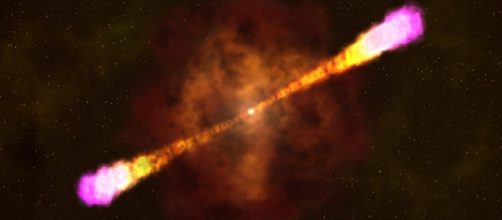An international team of researchers, led by the University of Maryland, has constructed one of the most detailed observations of what is considered to be the most energetic and explosive events in the universe.
Known as Gamma Ray Burst, these catastrophic events only last from a few milliseconds to about a minute. Despite being short-lived, the power generated by the explosion is considered to be second to the big bang.
Comprehensive coverage from different sources
The researchers were able to construct a detailed description of the explosive event with the help of ground- and space-based telescope observations.
The event, dubbed as GRB160625B, was first detected by NASA’s Fermi Gamma-ray Space Telescope. Optical light emissions from GRB160625B was also observed by Russia’s ground-based MASTER-IAC telescope.
X-ray and ultraviolet data were gathered using NASA's Swift Gamma-ray Burst Mission spacecraft, while infrared data and radio observations were made using the Reionization and Transient InfraRed/Optical Project camera and Australia Telescope Compact Array, respectively.
The “prompt” phase
The observations gathered from Fermi and the MASTER-IAC provided key insights in the so-called prompt phase of gamma ray bursts. The prompt phase is the initial, extremely bright phase of the burst. Based on the degree of polarization and spectrum observed in the GRB160625B, the researchers believe that the prompt phase of the burst was powered by synchrotron radiation, which results when electrons are sped up in a curved or spiral pathway.
There are two other potential drivers of gamma ray bursts being considered by astronomers. These are the black-body radiation and inverse Compton radiation. Black-body radiation results from the released of heat from an object, while inverse Compton radiation occurs when an accelerated particle transmits energy to the photon.
Evolution of gamma ray bursts
Aside from identifying the physical mechanism driving gamma ray burst, the researchers also determined how gamma ray bursts evolve as a dying star collapses to become a black hole. Astronomers are currently divided regarding what dominate the energy Emission Jets.
Some astronomers believe that the jets were dominated by strong magnetic fields, while others believe that the jets were dominated by matter.
Data from GRB160625B revealed that the jets actually have a dual, hybrid nature. This means both magnetic field and matter played a crucial role in the burst’s evolution.
Initially, the strong magnetic field produced by the black hole dominates the jets. As the jets grow, the magnetic field breaks down, losing its dominance. The degradation of the magnetic fields allows matter to take over and dominate the jets. However, there are times when a weak trace of magnetic field might survive.


